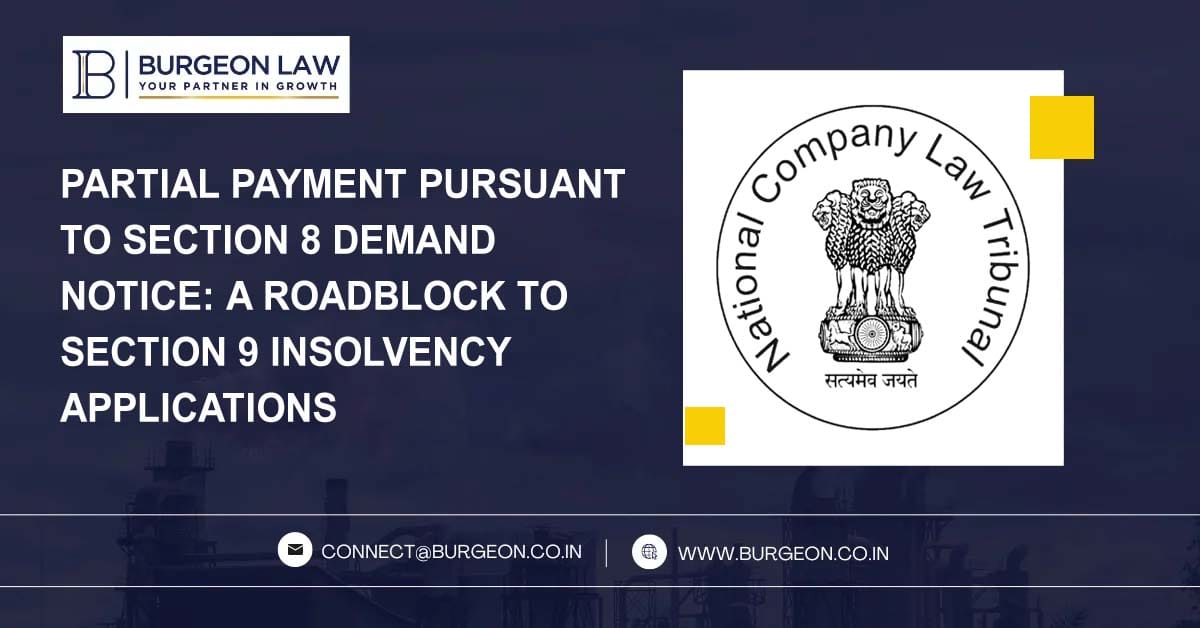The Insolvency and Bankruptcy Code, 2016 (IBC) has set a mandatory threshold limit for the initiation of the Corporate Insolvency Resolution Process (CIRP) under Section 9. An Operational Creditor can approach the National Company Law Tribunal (NCLT) only if the minimum default amount meets or exceeds INR 1 Crore, as per Section 4 of the IBC. A pertinent legal question arises when a Corporate Debtor, upon receiving a demand notice under Section 8, makes a partial payment to the Operational Creditor, thereby reducing the outstanding amount below the statutory threshold. The issue is whether such partial payment renders the Section 9 application non-maintainable.
Table of Contents
ToggleJudicial Precedents and Legal Interpretation
Recent rulings by the NCLT and National Company Law Appellate Tribunal (NCLAT) clarify that the maintainability of an application under Section 9 depends on the quantum of default on the date of filing the application and not on the date of default or the issuance of a demand notice under Section 8.
Case Analysis: CP (IB) No. 83/ALD/2022 (Mosco International Commodities Pvt. Ltd. v. SBEC Sugar Ltd.)
The Operational Creditor issued a demand notice under Section 8 of the IBC for an outstanding amount of INR 1,08,02,731/-. The Corporate Debtor subsequently made a partial payment of INR 13,13,886/- thereby, reducing the total due amount to INR 94,88,845/-. When the Operational Creditor filed an application under Section 9 of the IBC, the Corporate Debtor contested the maintainability on the ground that the outstanding amount was below the threshold of INR 1 Crore at the time of filing the application.
The NCLT Allahabad Bench, in its judgment dated 02.02.2024, reinforced the principle that the minimum threshold for filing an application under Section 9 of IBC must be met on the date of filing and not merely on the date of default and further provides clarity on the following principles:
Threshold Applicability: The INR 1 Crore default limit under Section 4 is tested on the date of filing, not at the time of demand notice.
Effect of Partial Payments: Payments made post-default but pre-filing reduce the outstanding liability, potentially making the application non-maintainable.
Interest Consideration: Unless expressly agreed upon, interest cannot be included to inflate the operational debt to meet the threshold.
Practical Implications:
Contradiction with IBC’s Objective: The IBC was designed to be a creditor-friendly law, ensuring the time-bound resolution of financial distress. However, if Corporate Debtors can avoid insolvency merely by reducing the claim below the threshold through partial payments, it undermines the essence of the Code. This could lead to a scenario where debtors selectively pay just enough to stall legal proceedings, keeping creditors in a perpetual cycle of unpaid dues.
Potential for Strategic Misuse: This precedent provides a viable defense mechanism to avoid CIRP proceedings for Corporate Debtors. By making partial payments strategically to bring outstanding dues below INR 1 Crore, the Corporate Debtor can essentially render an Application under Section 9 of IBC to be non-maintainable. Corporate Debtors may exploit this principle of law to avoid CIRP without actually resolving the underlying debt. This tactic is particularly detrimental to smaller Operational Creditors, for whom the IBC provides a primary mechanism for debt recovery.
Possible Recourses:
Re-evaluation of Legal Principles: Since the aforesaid judgment has been challenged before the Hon’ble NCLAT is currently sub judice, there is an opportunity for a re-evaluation of the legal principles involved. Courts should examine the intent behind such payments. If the partial payment is merely a tactical move to avoid CIRP without genuine settlement of dues, it should not affect the maintainability of an insolvency application. Courts must ensure that judicial interpretation aligns with the fundamental purpose of the IBC, ensuring a fair and effective resolution process, rather than allowing technical loopholes to be exploited.
Legislative or Policy Interventions: Given the impact of this ruling, the legislature or regulatory authorities like the IBBI may need to step in. Possible reforms could be requisite amendment in the IBC to specify that once a default of INR 1 Crore is established through a Section 8 notice, subsequent insignificant partial payments should not render the claim non-maintainable.
Conclusion:
This judgment, among others, introduces a significant challenge for Operational Creditors and could disrupt the efficiency of the IBC. While it provides a temporary safeguard for Corporate Debtors, it risks diluting the Code’s effectiveness by enabling strategic avoidance of insolvency proceedings. The ruling by Hon’ble NCLAT on this matter will be crucial in determining whether the law continues to protect creditors’ rights or opens the door for Corporate Debtors to exploit technical loopholes.
Our View:
As per Section 8 of the Insolvency and Bankruptcy Code (IBC), upon receipt of a demand notice from the Operational Creditor (OC) seeking payment of outstanding dues, the Corporate Debtor (CD) has only three possible courses of action:
- Inform the OC about the existence of a dispute regarding the outstanding amount or the pendency of a suit or arbitration proceedings;
- Pay the outstanding amount through electronic means and provide proof of payment; or
- Notify the OC of the encashment of a previously issued cheque.
The primary intent behind issuing a legal demand notice under Section 8 of the IBC is to prompt the CD to either clear the outstanding dues or face the initiation of the Corporate Insolvency Resolution Process (CIRP). The provision does not allow the CD to evade CIRP by making a partial payment of an insignificant amount merely to bring the debt below the statutory threshold of INR 1 crore. Therefore, the legal principle upheld by various courts, including the case discussed above, may require reconsideration.

